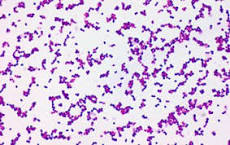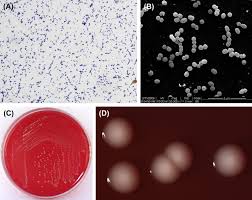Peptostreptococcus anaerobius: Difference between revisions
No edit summary |
|||
| Line 39: | Line 39: | ||
''Peptostreptococcus anaerobius'' contains a coccobacillary cell structure with a diameter of 0.5µ and 0.6µ [[#References|[2]]]. It aso contains a crystalline protein layer on top of the peptidoglycan layer within its cell wall [[#References|[4]]]. | ''Peptostreptococcus anaerobius'' contains a coccobacillary cell structure with a diameter of 0.5µ and 0.6µ [[#References|[2]]]. It aso contains a crystalline protein layer on top of the peptidoglycan layer within its cell wall [[#References|[4]]]. | ||
''P. anaerobius'' is known to be biochemically inactive and usually will not ferment carbohydrates. Its growth is stimulated by 0.02 polysorbate-80 [[#References|[1]]]. However, when oxygen and ''P. anaerobius'' come into contact with each other, its metabolism is greatly diminished. It uses ethanol, acetate, and 4-methylvalerate under anaerobic conditions as its main fermentation and metabolic products [[#References|[3]]]. It can produce CO2 and H2 from pyruvate under anaerobic conditions. When in glucose, it produces a large amount of gas and ammonia [[#References|[7]]]. | ''P. anaerobius'' is known to be biochemically inactive and usually will not ferment carbohydrates. Its growth is stimulated by 0.02 polysorbate-80 [[#References|[1]]]. However, when oxygen and ''P. anaerobius'' come into contact with each other, its metabolism is greatly diminished. It uses ethanol, acetate, and 4-methylvalerate under anaerobic conditions as its main fermentation and metabolic products [[#References|[3]]]. It can produce CO2 and H2 from pyruvate under anaerobic conditions. When in glucose, it produces a large amount of gas and ammonia [[#References|[7]]]. ''P. anaerobius'' also produces isocaproic acid as a major end product of metabolism and it is the only gram-positive anaerobic coccus to do so. The release of this acid aids researchers in identifying them more quickly [[#References| | ||
[[File:Peptostreptococcus second picture .jpg]] | [[File:Peptostreptococcus second picture .jpg]] | ||
Revision as of 19:10, 22 April 2020
Classification
Domain: Bacteria
Phylum: Firmicutes
Class: Clostridia
Order: Clostridiales
Family: Clostridiaceae
Genus: Peptostreptococcus
Species
Peptostreptococcus anaerobius or P. anaerobius
Type Strain: ATCC27337
|
NCBI: Taxonomy |
Description and Significance
Peptostreptococcus anaerobius is a slow growing, non-spore forming, Gram-positive anaerobic cocci (GPAC) bacteria. This means that it is not able to grow in oxygen-rich environments. P. anaerobius, under the correct harsh conditions, becomes an opportunistic pathogen that can cause multiple deep organ abscesses and infections in the abdominal cavity and female urogenitary tract [2]. Peptostreptococcus anaerobius is a short chain cocci which means it is a spherical bacterium with a size of 0.5µ to 0.6µ.
Peptostreptococcus anaerobius is one of the most frequently isolated and most common gram-positive cocci. It is part of the normal microbial flora within the human mouth and female genitourinary system [5]. Their optimal growth temperature is 37°C on blood agar where they form a raised, white, glossy colony [7].
Peptostreptococcus anaerobius displays a large importance in the field of medicine. As mentioned, P. anaerobius is an opportunistic pathogen. This means that it can cause infections all throughout the human body. Some infections can be very severe while others can be small. However, rates of infection due to P. anaerobius and other GPAC's are increasing, which puts an even larger importance on the microbe itself. Researching their properties and their resistance to antibiotics is key to not only understanding the microbe but combatting future infections.
Genome Structure
The content within the genome of Peptostreptococcus anaerobius has been scarcely observed and researched. The DNA base composition of P. anaerobius is 33-34% and its type strain is ATCC27337 [1]. Its genome has been found to be much smaller than the other Peptostreptococcus species [2].
Cell Structure, Metabolism and Life Cycle
Peptostreptococcus anaerobius contains a coccobacillary cell structure with a diameter of 0.5µ and 0.6µ [2]. It aso contains a crystalline protein layer on top of the peptidoglycan layer within its cell wall [4].
P. anaerobius is known to be biochemically inactive and usually will not ferment carbohydrates. Its growth is stimulated by 0.02 polysorbate-80 [1]. However, when oxygen and P. anaerobius come into contact with each other, its metabolism is greatly diminished. It uses ethanol, acetate, and 4-methylvalerate under anaerobic conditions as its main fermentation and metabolic products [3]. It can produce CO2 and H2 from pyruvate under anaerobic conditions. When in glucose, it produces a large amount of gas and ammonia [7]. P. anaerobius also produces isocaproic acid as a major end product of metabolism and it is the only gram-positive anaerobic coccus to do so. The release of this acid aids researchers in identifying them more quickly [[#References|
Ecology and Pathogenesis
P. anaerobius is known to be an opportunistic pathogen. It is one of the most common GPAC associated with infections of the abdominal cavity and female urogenitary tract [2]. However, P. anaerobius has been isolated from rat, mice, cat, dog, monkey, and rabbit feces as well. Anaerboes are known to cause 8-11% causes of bacteremia and Peptostreptococcus accounts for 25-30% of all isolated anaerobes [6]. The most common female infection by P. anaerobius is bacterial vaginosis. However, it is know to create other abnormalities such as abscesses in different parts of the body and has the potential to cause orbital disease [2].
Peptostreptococcus anaerobius is not very susceptible to antibiotics either. It was found that there were more strains of P. anaerobius that were resistant to antibiotics than any other Peptostreptococcus species [2]. It was not until recently that a new antibiotic, Oritavancin, was able to combat P. anaerobius. It is a glycopeptide antibiotic that inhibits bacterial cell-wall formation through blocking the transglycosylation step in peptidoglycan hydrolysis [2].
Peptostreptococcus anaerobius has a commensal symbiosis with another microbe, Prevotella bivia. This relationship occurs during bacterial vaginosis where P. bivia supports the growth of P. anaerobius because P. bivia has a net accumulation of amino acids. Otherwise, P. anaerobius would not be able to grow in vaginal defined mediums [2].
References
[1] Brook, Itzhak. “Peptostreptococcus Anaerobius.” Peptostreptococcus Anaerobius - an Overview | ScienceDirect Topics, 2017.
[2] Carmel, Elizabeth, and Inga Maria Frick. “Gram-Positive Anaerobic Cocci – Commensals and Opportunistic Pathogens.” OUP Academic, Oxford University Press, 1 July 2013.
[3] Hoshino, Esturo, et al. “Oxygen and the Metabolism of Peptostreptococcus Anaerobius.” Microbiology Society, Department of Oral Microbiology, 1978.
[4] Kotiranta, A, et al. “Crystalline Surface Protein of Peptostreptococcus Anaerobius.” Microbiology (Reading, England), U.S. National Library of Medicine, May 1995.
[5] Murdoch, D. A. “Gram-Positive Anaerobic Cocci.” Clinical Microbiology Reviews, American Society for Microbiology Journals, 1 Jan. 1998.
[6] “Peptostreptococcus Spp.” MSDSonline, Public Health Agency of Canada, 2010.
[7] “Peptostreptococcus.” Peptostreptococcus - an Overview | ScienceDirect Topics, Atlas of Oral Microbiology, 2015.
Author
Page authored by Eric Salzeider, student of Prof. Jay Lennon at IndianaUniversity.


